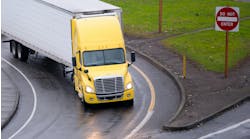ATLANTA. Tom McLeod, founder, president, and CEO of McLeod Software, is fond of saying that, “one of the more immutable laws of the universe is that we reap what we sow.” And at least from his perspective, motor carriers will need to do an awful lot of reaping based on the amount of change now rapidly occurring in the trucking industry.
For starters, the rapid growth of e-commerce – what many are also dubbing “The Amazon Effect” – is creating big shifts in freight patterns across the U.S., he said.
McLeod noted that 10% of all retail sales are occurring online, and while that might not sound like much that will force 20% of existing brick-and-mortar retail stories to close in the next five to 10 years.
Parcel carriers – especially UPS, FedEx, and the U.S. Postal Service – are the “big winners” of this shift right now, he said.
“They are making the trip consumers used to make to the department or grocery store," McLeod pointed out during a speech and in a roundtable meeting with reporters here at the McLeod 2017 User Conference. “This is new freight business.”
He said that trend is reflected in the 5.4% compound annual growth rate (CAGR) of the parcel business between 2011 and 2016 – contrasted to the CAGR of 2.6% experienced by LTL carriers and 0.6% rate experienced by TL carriers over the same period.
Only part of the TL business is changing, though, McLeod noted, with “business to business” shipments of raw materials to factories and the like the least affected. It’s in the shipment of finished goods where the freight pattern shift is most apparent. Point-to-point TL shipments are now becoming multi-stop loads, with residential deliveries making up part of those stops as well.
This is big deal because 70% of the U.S. economy is driven by consumer activity. “And we’re still on the front end of this disruption,” he stressed. “This is a just a basic disruption of the TL model, especially when it comes to the final mile.”
Yet McLeod also emphasized that anytime there is a challenge or problem in transportation, it creates an opportunity.
“So we need to be encouraged to look for those opportunities,” he pointed out. “We believe there are many opportunities for truckload carriers to enter this market, which used to be the exclusive province of the LTL carriers.”
That is one reason why his company developed LoadMaster Final Mile, a new module that will be available before the end of the year in the company’s LoadMaster Enterprise version 17.2 release.
It’s a product designed to give TL carriers a highly capable system for final mile delivery operations, supporting multiple pickups, terminal or warehouse based cross docking, delivery planning and routing.
Taking advantage of such “opportunities” will also be critical in light of the rapidly-approaching electronic logging device (ELD) implementation deadline of December 18 as a significant portion of the industry has not yet complied with the mandate, McLeod said.
“I am still surprised at all the new orders we’re getting where they’ve not yet selected an ELD provider,” he noted. “At this point it seems almost too late to do it.”
According to the numbers he’s seen, roughly 15% to 20% of TL sector – comprised mostly of smaller motor carriers – has not adopted ELDs yet and McLeod warned that installing an ELD is not easy.
“There’s a steep learning curve in terms of learning how to manage the electronic information coming from an ELD,” he stressed. “You can’t pull into a truck stop on December 17, install one, flip the switch, and you are ready to go.”
McLeod predicted that the trucking productivity losses from switching over to ELDs will be in the 5% to 7% range as well. “The 450 mile runs many carriers make in a day they won’t be able to do anymore,” he added. “A lot of smaller carriers may decide to close up shop and they still provide a lot of necessary capacity. But this will also create opportunity for other carriers.”




